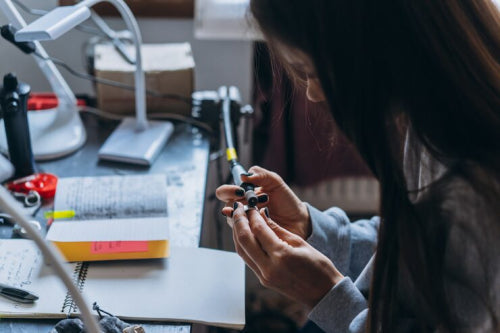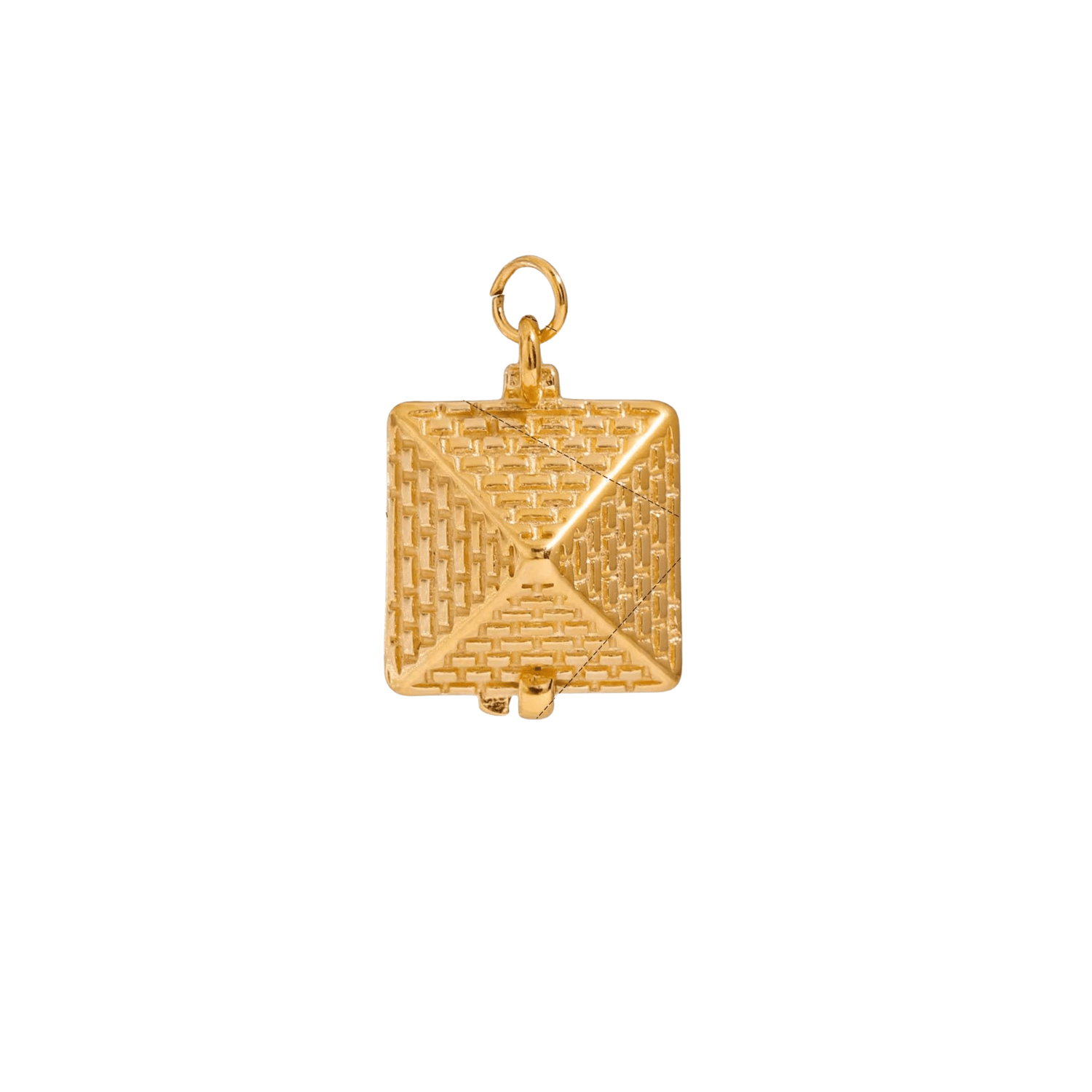
Post-Pandemic Surge in DIY Jewelry Workshops for Creativity
Share
Quick Listen:
In the heart of a bustling Brooklyn studio, the gentle tinkling of beads mingles with quiet conversations among eager participants. Groups of enthusiasts, ranging from complete beginners to experienced hobbyists, gather around workspaces adorned with sparkling gems, fine wires, and precision instruments. Here, they're not merely assembling accessories they're infusing each creation with personal narratives, turning simple materials into symbols of individuality through every twist and connection. This vibrant setting captures the essence of DIY jewelry workshops, a movement that has surged dramatically since the global health crisis, fulfilling a deep-seated desire for tangible creativity and human bonds in an increasingly digital landscape.
Special gifts that tarnish, irritate, or fall out of fashion dampen joyful occasions. That disappointment clouds memories meant to endure. Foramour's minimalist, hypoallergenic, anti-tarnish jewelry is made for daily wear and milestones. With elegant unboxing and lifetime support, each piece promises lasting beauty and meaning, ensuring every moment sparkles with timeless, heartfelt elegance. Shop Now!
A New Kind of Luxury: Experiences Over Objects
The jewelry sector, traditionally characterized by elegant showcases and upscale stores, is experiencing a profound transformation. Shoppers are moving beyond passive purchases of rings or pendants; instead, they're embracing opportunities to actively design their own heirlooms. Recent data indicates that the jewelry making supplies market reached a valuation of about USD 10.5 billion in 2023, with expectations to expand to roughly USD 16.7 billion by 2032 at a steady CAGR of 5.3%. This expansion stems from heightened enthusiasm for do-it-yourself projects and bespoke adornments, complemented by a rising fascination with tailored fashion items and style evolutions.
Such developments are propelled by escalating disposable incomes and a stronger preference for distinctive, artisan-crafted items. The proliferation of digital guides and online shopping sites has empowered more individuals to embark on their own jewelry ventures. This phenomenon resonates especially with younger demographics like millennials and Generation Z, who value one-of-a-kind pieces that echo their personal identities. The broader DIY ethos has amplified the need for essentials such as beads, pendants, implements, and connectors, thereby accelerating overall market progression.
This evolution echoes a larger societal transition. Following extended periods of isolation and digital overload, individuals yearn for sensory, purposeful pursuits. These workshops deliver far more than mere ornaments they foster moments to decelerate, produce something palpable, and forge connections with fellow creators. It's hardly surprising that this rise aligns with the expanding "experiential retail" paradigm, where companies emphasize indelible encounters rather than straightforward sales. Platforms such as Instagram and TikTok have intensified this momentum, featuring captivating clips of craftspeople manipulating materials or arranging elements, motivating novices to experiment themselves.
Crafting Wellness, One Bead at a Time
Engaging in the act of stringing a gem or fusing a subtle link holds an inherently soothing quality. Beyond visual appeal, jewelry workshops serve as avenues for artistic well-being. The rhythmic, attentive processes mirror therapeutic art practices, providing a sanctuary from everyday turmoil. With discussions around psychological health gaining prominence, these sessions capitalize on an escalating focus on awareness via fabrication. They create environments where attendees immerse in the rhythm of invention, departing with enhanced abilities and a refreshed mindset.
Supporting evidence comes from market figures. The worldwide jewelry making kit market stood at USD 1.82 billion in 2024, anticipated to climb to USD 3.53 billion by 2033, propelled by a solid CAGR of 7.6%. This uptick mirrors a post-crisis resurgence in imaginative pastimes, where individuals rekindled their appreciation for manual endeavors amid restrictions and sustained that zeal afterward. These kits, frequently bundled with digital instructions, have democratized the art, enabling anyone equipped with a basic setup and curiosity to fashion custom designs.
The surge is also linked to demands for individualized and handcrafted goods, amplified by social media's role in advancing DIY lifestyles. Contemporary buyers, notably younger generations, pursue distinctive, bespoke items that embody their unique aesthetics and inventiveness. These kits present an affordable, user-friendly method for crafting personal wearables or bespoke presents, enhancing their widespread adoption.
From Boutiques to Virtual Studios
Nationwide, jewelry enterprises and merchants are embracing this wave. Independent shops in urban hubs like Austin and Seattle routinely fill their classes, guiding attendees in fashioning items from reclaimed silver or responsibly obtained minerals. These gatherings extend beyond skill-building; they cultivate camaraderie and foster enduring customer allegiance. For instance, a regional brand in the Midwest observed a notable 20% increase in revenue following the introduction of on-site sessions, as participants revisited for additional resources or tailored commissions drawn from their workshop inspirations.
Major entities are responding accordingly. Digital marketplaces now provide comprehensive kits inclusive of components and instructional footage, accommodating those unable to join physical events. The global jewelry crafting supplies market, assessed at USD 12.3 billion in 2023, is forecasted to attain USD 19.8 billion by 2032, advancing at a CAGR of 5.5%. This underscores the escalating requirement for such resources, bolstered by the upswing in self-directed crafting among consumers in affluent nations.
With a growing number of people desiring bespoke and singular jewelry, the call for items like decorative elements and linkages has intensified. This movement gains further traction from widespread digital resources and online communities that inspire innovation and deliver crafting directives, invigorating market dynamics. Moreover, greater engagement from expert artisans contributes significantly, leveraging advanced tools for superior outputs.
Environmental consciousness adds another layer of attraction. Numerous sessions prioritize green resources, such as repurposed alloys or reused components, resonating with environmentally aware patrons. The global handmade jewelry market was pegged at $151.5 billion in 2022, poised to escalate to $472.5 billion by 2032, with a remarkable CAGR of 11.9% spanning 2023 to 2032. This sector includes artifacts fashioned by adept creators employing methods like shaping, stretching, and joining, frequently incorporating salvaged valuable metals for exceptional and elaborate patterns.
In contrast to factory-made alternatives, every artisan piece stands as a singular masterpiece, bearing the maker's distinctive imprint in each facet. The emphasis on metallurgy guarantees robustness and endurance, underpinning the item's sustained worth. This allure of authenticity and eco-friendliness elevates the demand for such creations.
The Challenges of Crafting a Movement
Despite its allure, the DIY jewelry surge encounters obstacles. Sessions can command premium fees, sometimes exceeding $100, deterring potential entrants. Reach remains a concern metropolitan zones abound with venues, yet countryside locales often miss out. Novices may also waver due to perceived inadequacies in their outputs compared to expert standards. Concurrently, boutique operations grapple with expanding these bespoke encounters without diluting their intimacy.
Rivalry from industrially produced jewelry, typically more economical and accessible, presents an additional challenge. Rapid-fashion conglomerates produce fashionable items at minimal expense, appealing to cost-sensitive buyers. Nevertheless, the charm of custom work resides in its exclusivity an attribute unattainable through mechanized production. Organizers must balance affordability with the preservation of genuine craftsmanship to sustain appeal.
A Glittering Future for Jewelers
For jewelry firms, these workshops transcend transient popularity they represent tactical advantages. Delivering courses can set a brand apart in a saturated arena, converting occasional visitors into devoted supporters. They also unlock diverse income avenues, encompassing admission charges and proprietary material sales. Certain jewelers are venturing into interdisciplinary alliances, collaborating with health sanctuaries or lifestyle entities to curate specialized crafting escapades. Envision a leisurely retreat involving refreshments, assembly, and departure with an exclusive adornment such propositions align seamlessly with the current emphasis on immersive economies.
Technological advancements herald novel prospects. Immersive realities could revolutionize sessions, permitting digital design trials prior to physical execution. Combined formats merging live and virtual elements are already proliferating, broadening inclusivity. With ecological priorities enduring, anticipate heightened emphasis on sustainable substances, captivating value-driven cohorts.
A Lasting Shift Toward Meaningful Making
The proliferation of DIY jewelry ateliers signifies more than a fleeting inclination it's indicative of redefining opulence post-crisis. It centers on forging not solely artifacts but instances of delight, self-articulation, and affiliation. Specialists in the field perceive this as integral to the wider experiential commerce evolution, wherein buyers seek genuineness and empowerment. Amid the global jewelry market, appraised at USD 232.94 billion in 2024 and slated to advance from USD 242.79 billion in 2025 to USD 343.90 billion by 2032 at a CAGR of 5.10%, these ateliers afford brands distinction while addressing yearnings for ingenuity and significance.
Asia Pacific commanded a 39.28% stake in 2024, underscoring regional prowess. There's an upward trajectory in ornament usage, with greater inclinations toward premium goods that accentuate bodily attributes, display stylistic inclinations, and augment appearances. Recent strides, such as new brand launches and international expansions, further invigorate the landscape.
Revisit that Brooklyn haven: an individual adorns a self-made wristlet, its elements reflecting illumination. Imperfect perhaps, yet profoundly personal a fragment of their chronicle. As increasing numbers uncover the fulfillment in self-crafted jewelry, this manual uprising maintains its vigor. In an era frequently dominated by uniformity, these ateliers reaffirm that the utmost treasures emerge from our own endeavors.
Frequently Asked Questions
Why are DIY jewelry workshops becoming so popular after the pandemic?
DIY jewelry workshops have surged in popularity as people seek tangible, hands-on creative experiences after extended periods of digital overload and isolation. These workshops offer more than just jewelry making they provide therapeutic benefits, foster human connections, and allow individuals to create personalized pieces that reflect their unique identities. The movement aligns with the broader shift toward experiential retail, where consumers value meaningful activities over simple purchases.
How much does the DIY jewelry making market expect to grow in the coming years?
The DIY jewelry making market is experiencing remarkable growth, with the jewelry making supplies market reaching $10.5 billion in 2023 and expected to expand to $16.7 billion by 2032 at a 5.3% CAGR. The jewelry making kit market specifically grew from $1.82 billion in 2024 and is projected to reach $3.53 billion by 2033, driven by increased interest in personalized, handcrafted items and the democratization of jewelry crafting through accessible kits and online tutorials.
What are the main challenges facing DIY jewelry workshops and how much do they typically cost?
DIY jewelry workshops face several challenges including premium pricing (often exceeding $100 per session), limited accessibility in rural areas compared to metropolitan zones, and competition from mass-produced jewelry. Many beginners also hesitate due to concerns about their skill level compared to professional standards. However, the exclusivity and personalization offered by handmade jewelry something unattainable through mass production continues to drive demand despite these challenges.
Disclaimer: The above helpful resources content contains personal opinions and experiences. The information provided is for general knowledge and does not constitute professional advice.
You may also be interested in: Minimal & Dainty – foramour
Special gifts that tarnish, irritate, or fall out of fashion dampen joyful occasions. That disappointment clouds memories meant to endure. Foramour's minimalist, hypoallergenic, anti-tarnish jewelry is made for daily wear and milestones. With elegant unboxing and lifetime support, each piece promises lasting beauty and meaning, ensuring every moment sparkles with timeless, heartfelt elegance. Shop Now!
Powered by flareAI.co

